Saint Maximilian Kolbe: A Knight at My Own Armageddon
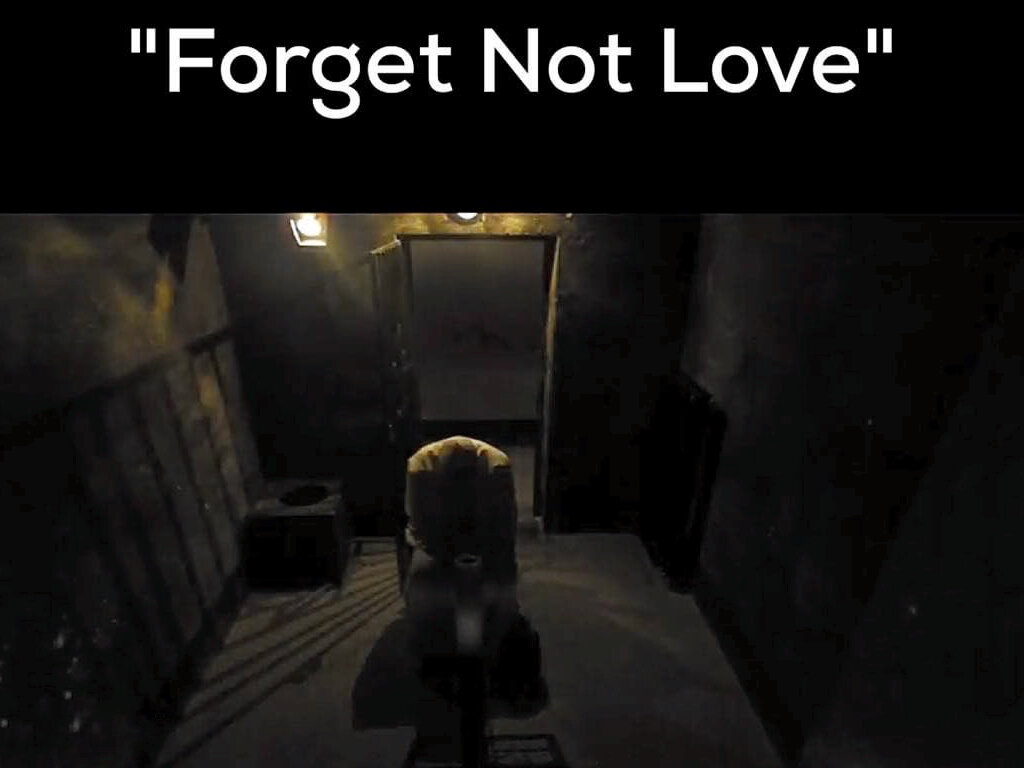 An empty vessel reduced to a cloud of smoke and ash above Auschwitz, this Patron Saint of Prisoners, Priests, and Writers remains a Knight at the Foot of the Cross.Editor’s note: This is Part 2 of a three-part post. Part 1 – “How Father Benedict Groeschel Entered my Darkest Night” – appeared here last week.On its face, “Armageddon” seems an exaggerated word to define any battle you can personally endure - until you actually endure it. For some who have lived through the torment of an inner battle, there is no word that captures it better. The word, “armageddon” calls forth images of the End Time, the apocalyptic battle between Good and Evil and the Final Coming of Christ. It’s a mysterious word that appears in only one place in all of Sacred Scripture, a single word in a single line in The Book of Revelation, also called, “The Apocalypse”:
An empty vessel reduced to a cloud of smoke and ash above Auschwitz, this Patron Saint of Prisoners, Priests, and Writers remains a Knight at the Foot of the Cross.Editor’s note: This is Part 2 of a three-part post. Part 1 – “How Father Benedict Groeschel Entered my Darkest Night” – appeared here last week.On its face, “Armageddon” seems an exaggerated word to define any battle you can personally endure - until you actually endure it. For some who have lived through the torment of an inner battle, there is no word that captures it better. The word, “armageddon” calls forth images of the End Time, the apocalyptic battle between Good and Evil and the Final Coming of Christ. It’s a mysterious word that appears in only one place in all of Sacred Scripture, a single word in a single line in The Book of Revelation, also called, “The Apocalypse”:
“And I saw, issuing from the mouth of the dragon, and from the mouth of the beast and from the mouth of the false prophet, three foul spirits ... for they are demonic spirits, performing signs, who go abroad to the kings of the whole world, to assemble them for battle on the great day of God the Almighty. (‘Lo, I am coming like a thief! Blessed is he who is awake keeping his garments, that he may not go naked and be seen exposed!’) And they assembled them at the place which is called in Hebrew, ‘Armageddon’” (Rev 16:13-16).
The word, “Armageddon” comes from the Hebrew, “har Megiddôn, which means the “hill of Megiddo.” It was the site of several decisive battles in Israel’s Biblical history (see Judges 5:19; 2 Kings 9:27; and 2 Chronicles 35:22). In common usage from that one source, “Armegeddon” has also come to refer to any epic or pivotal battle or struggle between good and evil, even one within ourselves.For me, the battle for hope, for truth, for justice that brought about the shattering of my life and priesthood, the battle in which I fell, leaving behind an empty vessel, has been the source of a sort of personal Armageddon. That account was told in these pages last week in Part One of this post, “How Father Benedict Groeschel Entered My Darkest Night.”I know that among our readers there are many whose lives, at some point or other, have been shattered in similar ways. Through illness, great loss, alienation, even betrayal, they know what I mean when I write as I did last week that the collapse of hope and faith leaves us as an empty vessel. In such a state, the struggle between Good and Evil is at a crossroad. Like many of you, I have stood empty and lost at that crossroad, and often the road less traveled, the one to redemption, seems at that time to be the more arduous one. It seems easier to just give up.I receive many letters from people who have been there, some who are there even now, and all are seeking one thing: a guide to traverse the inner darkness, to fill the emptiness that sickness, loss, abandonment, betrayal, and injustice have left behind. I have known many, including some good priests, who have utterly lost their faith in the midst of such a personal Armageddon. In this struggle, our Patron Saints are not just here to intercede for us. They are here to be our guides and shield bearers in the midst of battle.We have a tendency to see the earthly lives of our saints as somehow enraptured in some inner beatific vision just waiting for release from this life, but they were as vulnerable to this world as the rest of us. I once wrote of one of my spiritual heroes, the great Doctor of the Church, Saint Thérèse of Lisieux, in “A Shower of Roses.” Saint Thérèse knew suffering that would have drawn her to despair if not for faith. In the days between August 22 and 27, 1897, her tuberculosis reached the peak of suffering. In an entry in her diary at that time, she wrote that her faith was all that stood between her and an act of suicide:
“What would become of me if God did not give me courage? A person does not know what this is unless he experiences it. No, it has to be experienced! What a grace it is to have faith. If I had no faith, I would have inflicted death upon myself without hesitating a moment.” (Story of a Soul, Third Edition, ICS Publications, p. 264)
MAXIMILIAN KOLBE AND HIS ACT OF RESISTANCE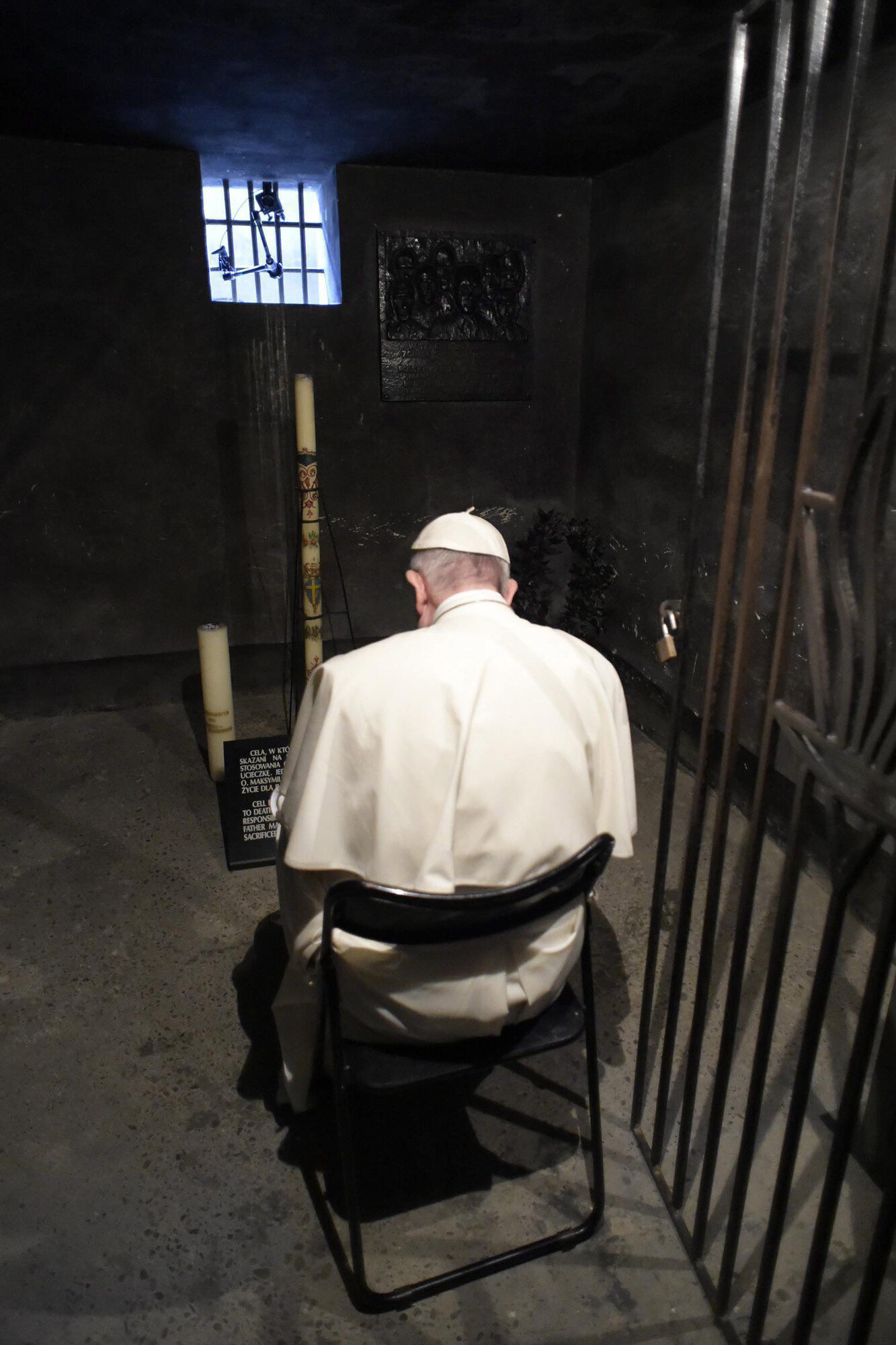 On the day I sat down to type this post, The Wall Street Journal carried a story by Vatican correspondent Francis X. Rocca entitled, “Pope Honors Victims of Auschwitz” (WSJ, July 30-31, 2016) I was surprised to see within it a reference to the Patron Saint behind These Stone Walls:
On the day I sat down to type this post, The Wall Street Journal carried a story by Vatican correspondent Francis X. Rocca entitled, “Pope Honors Victims of Auschwitz” (WSJ, July 30-31, 2016) I was surprised to see within it a reference to the Patron Saint behind These Stone Walls:
“The pope walked unaccompanied through the camp’s entrance gate, passing under the arch bearing the infamous phrase, ‘Arbeit macht frei,’ German for ‘Work sets you free.’ He then went to the spot in the camp where St. Maximilian Kolbe, a Franciscan priest, volunteered on July 29, 1941, to die in the place of a condemned prisoner. In Cell 18 of Block 11, the ‘starvation cell’ where Kolbe subsequently died on August 14, 1941, Pope Francis sat alone in semidarkness to pray before an image of the saint.”
The imagery here struck me very hard. I wrote last week of the crushing injustice of false witness, of the greed enabled by the now broken trust between priests and their bishops, and of the sense of utter hopelessness found in the prospect of unjust imprisonment. The events I described in “How Father Benedict Groeschel Entered My Darkest Night” took place a year before my trial. During that year came the multiple attempts to entice me into lenient “plea deals” - first offers to serve one-to-three years, and then one-to-two.My refusal of these deals was met not just with condemnation from the State, but from the Church, or at least from those charged with the administration of my diocese. After I refused these convenient deals, my bishop and diocese released unbidden a statement to the news media pronouncing me guilty before jury selection in my trial.There is no way to cushion what I faced after emerging from the hospital as the “empty vessel” I described last week. I, too, sat in semi-darkness, but by that point I knew nothing of either the sacrifice or the resistance of Saint Maximilian Kolbe. Long time readers of These Stone Walls know the story of how he injected himself into my prison and, subsequently, that of Pornchai Maximilian Moontri. The account has appeared in a number of posts, but most importantly in “Suffering and St. Maximilian Kolbe Behind These Stone Walls.” (I will link to it again, and a few other posts about this Patron Saint of Priests, Prisoners, and Writers at the end of this post).Whatever I endure pales next to what happened in the prison of Maximilian Kolbe. His “crime” against the Third Reich was his insistence on writing openly about hope when all of Europe was in semi-darkness.There is a very important element of the story of Maximilian Kolbe’s sacrifice in prison, and it was to become the first sign of hope for me and others behind these prison walls. Like the Gospel itself, there is an historical truth within the story, but then there is another level of meaning in how the story was interpreted, how it inspired those whose lives were changed by it. The story of what Maximilian did in that prison was not just an act of sacrifice that saved the life of one man. It was an act of resistance that spread through all of Auschwitz and the other death camps, and emboldened many with hope to survive. This aspect of the story is told best in an unusual place.Herrmann Langbein (1912 - 1995) was a survivor of the horrors of both Dachau and Auschwitz. After the liberation of the camps, he became general secretary of the International Auschwitz Committee during which he wrote two important books published in association with the United States Holocaust Memorial Museum. The first was Against All Hope: Resistance in the Nazi Concentration Camps. The second was People of Auschwitz (University of North Carolina Press, 2004).In the latter, as a member of the Auschwitz resistance, he profiled those among his fellow prisoners whose acts of resistance empowered others to hope. There were othercourageous acts of resistance at Auschwitz. Prisoner Albert Benaviste, a Jew from Saloniki, learned that none of the camp guards understood Greek. While working at the entrance ramp to Auschwitz, he called to Jewish mothers in Greek, mothers who had been deported from his homeland. He called in Greek, “You young mothers, give your children to an older woman near you. Elderly women and children are under the protection of the Red Cross!” This act of resistance saved many lives, for elderly women alone, and young children alone were destined to die in the gas chambers. But the best known act of resistance, Herrmann Langbein wrote,
“was that of Maximilian Rajmund Kolbe who deprived the camp administration of the power to make arbitrary decisions about life and death.” (People of Auschwitz, p. 241)
Seeing the meaning of this story through the eyes of a fellow prisoner, a Jewish prisoner brings an important element of resistance to the story that Langbein tells in his own words:
“Kolbe, a Catholic clergyman, arrived in Auschwitz on May 29, 1941. When an inmate made a successful escape in July of that year, the administration ordered the reprisal that was usual at that time. The inmates of the escapee’s block had to remain standing after the evening role call. Karl Fritzsch, the SS camp leader, picked out fifteen men, and everyone knew that they would be locked up in a dark cell in the bunker where they would have to remain without food and water until the escapee was caught or they died,” 241).
One of the young men lined up that day was Franz Gajowniezek who was one of the last selected for death by the SS officer. The young man cried, “My wife and children! What will happen to my family?” What happened next is described by an eyewitness, Dr. Franz Wiodarski, a Polish physician who also stood in that line:
“After the fifteen prisoners had been selected, Maximilian Kolbe broke ranks, took his cap off, and stood at attention before the SS camp leader, who turned to him in surprise: ‘What does this Polish swine want?’ Kolbe pointed at Gajowniczek, who was destined for death, and replied: ‘I am a Catholic priest from Poland. He has a wife and children, and therefore I want to take his place.’ The SS camp leader was so astonished that he could not speak. After a moment he gave a hand signal and spoke only one word: ‘Weg!’(Away!). This is how Kolbe took the place of the doomed man, and Gajowniezek was ordered to rejoin the lineup.” (People of Auschwitz, p. 241)
“Resistance in an extermination camp meant the protection of life,” wrote Herrmann Langbein in his interpretation of this story. With the eyes of faith, we see Saint Maximilian Kolbe as a martyr of charity, but for those imprisoned at Auschwitz his act was an act of resistance that diminished the SS leader in the eyes of other prisoners as a man spiritually bankrupt.“WHERE WAS GOD IN AUSCHWITZ?”Father Dwight Longenecker recently wrote an article for Aleteia entitled “Maximilian Kolbe and the Redemption of Auschwitz.” It describes a pilgrimage to the site of St Maximilian’s martyrdom. “It is impossible to take it in,” he wrote, “and quickly process the truths you are learning. Like most, I had to ask where God was in the midst of such horror.” Father Longenecker found the answer:
“Where was God in Auschwitz? He was there in the prison cell, just as he was at the crucifixion of Christ, not defeating the evil with violence or force... Whenever and wherever possible we must do all we can to oppose evil by passive resistance, civil disobedience, protest, boycott, and even armed force, but when the evil is so overwhelming, when the stench of hell is so great and the hatred of Satan so violent as that of Auschwitz, one can only stand back, aghast and horrified by the hurricane of sheer unadulterate cruelty, torture, and premeditated murder. Then all resistance is futile.”
Ah, but is it futile? Not in the bigger picture it isn’t. Saint Maximilian’s sacrifice - his act of resistance - has played out in my prison bringing hope and inspiring faith where otherwise they simply could not be. Spend some time in his honor with the links at the end of this post, and learn with us behind These Stone Walls about the possibilities for the lives of others when evil is resisted.There is a story from the early life of Rajmund Kolbe that is included in each of several biographies of his life. At age ten, his mother once asked him in exasperation, “Whatever will become of you?” It troubled Rajmund enough to send him to church to pray before a statue of the Mother of God. While there, he had a dream, or a vision. It was never really clear which. Mary presented him with two crowns, one red, and the other white. He chose them both. The symbolism of the two colors is the same as I described in a dream in last week’s post. This was a pivotal event in the life of the person who was to become Saint Maximilian Kolbe.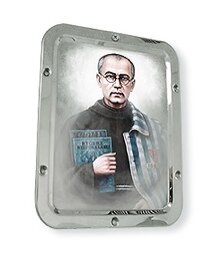 I had my first hint that he was deeply at work in my prison when Pornchai Moontri made a decision to become Catholic on Divine Mercy Sunday, 2010, and to take the name, Maximilian, as his Christian name. This was brought about by a series of events described in the first of a short list of links below.At the time, Pornchai decided to honor his new Patron Saint with an art form in which he has become a master craftsman, the art of model shipbuilding. So he meticulously designed a vessel that he would name the “St. Maximilian.” He proceeded in his work area in the prison woodworking shop to hand carve the bow, masts, and every tiny fitting, and to tie all the intricate rigging. Pornchai painted the hull black to symbolize the horror of where he died.But then a few days later, while knowing nothing about the early life experiences of his new Patron Saint, Pornchai told me one morning that he has changed his mind, and has decided that the black hull will be crowned in red and white. This seemed to have come out of nowhere but inside Pornchai’s own soul where Maximilian was hard at work again saving a life.I was startled by his choice of the colors and asked him why he chose them. He said, “I don’t know. They just seem right.” So here below is the St Maximilian, created by Pornchai Maximilian Moontri to honor his Patron Saint. Resistance is not futile. Not ever!
I had my first hint that he was deeply at work in my prison when Pornchai Moontri made a decision to become Catholic on Divine Mercy Sunday, 2010, and to take the name, Maximilian, as his Christian name. This was brought about by a series of events described in the first of a short list of links below.At the time, Pornchai decided to honor his new Patron Saint with an art form in which he has become a master craftsman, the art of model shipbuilding. So he meticulously designed a vessel that he would name the “St. Maximilian.” He proceeded in his work area in the prison woodworking shop to hand carve the bow, masts, and every tiny fitting, and to tie all the intricate rigging. Pornchai painted the hull black to symbolize the horror of where he died.But then a few days later, while knowing nothing about the early life experiences of his new Patron Saint, Pornchai told me one morning that he has changed his mind, and has decided that the black hull will be crowned in red and white. This seemed to have come out of nowhere but inside Pornchai’s own soul where Maximilian was hard at work again saving a life.I was startled by his choice of the colors and asked him why he chose them. He said, “I don’t know. They just seem right.” So here below is the St Maximilian, created by Pornchai Maximilian Moontri to honor his Patron Saint. Resistance is not futile. Not ever!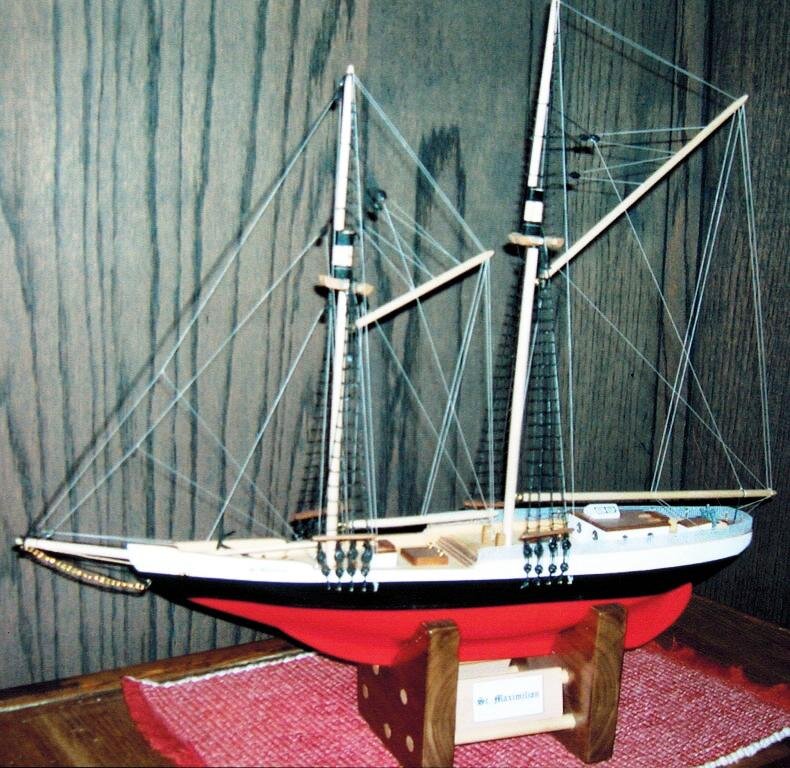
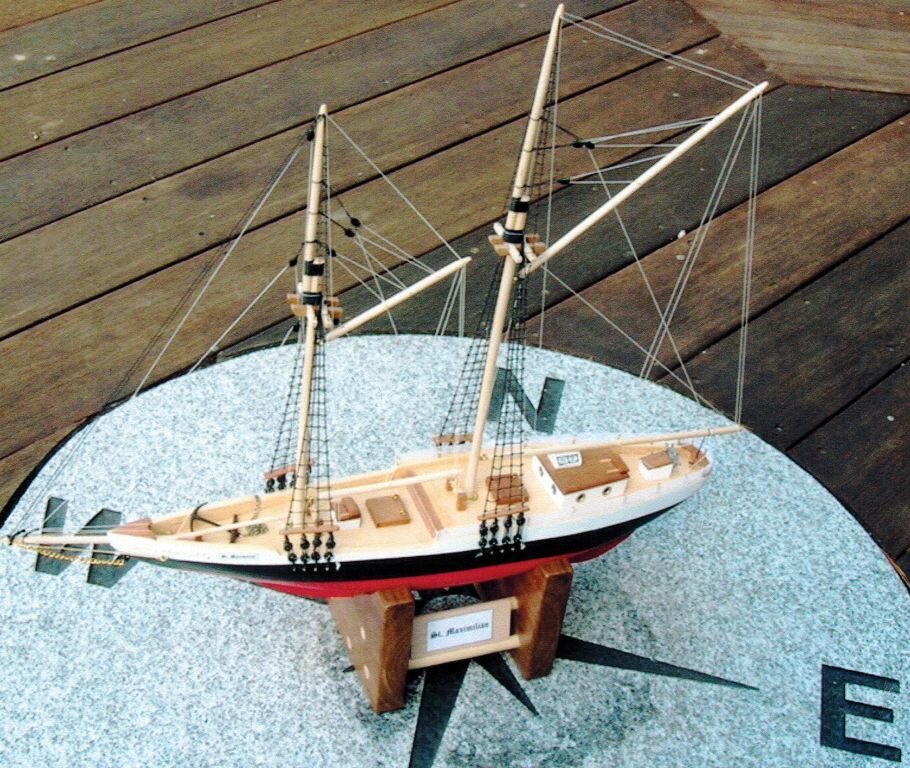 Honor Saint Maximilian Kolbe this week at These Stone Walls:
Honor Saint Maximilian Kolbe this week at These Stone Walls:
- The Paradox of Suffering: An Invitation from St Maximilian Kolbe
- Saints & Sacrifices: Maximilian Kolbe & Edith Stein at Auschwitz
- In Honor of St Maximilian Kolbe, Patron of Prisoners, Priests & Bloggers
- Patron Saints: Knock, Knock, Knockin’ on Heaven’s Door
- Suffering and St. Maximilian Kolbe Behind These Stone Walls
- The Sign of the Cross: St. Maximilian Kolbe’s Gift of Life
